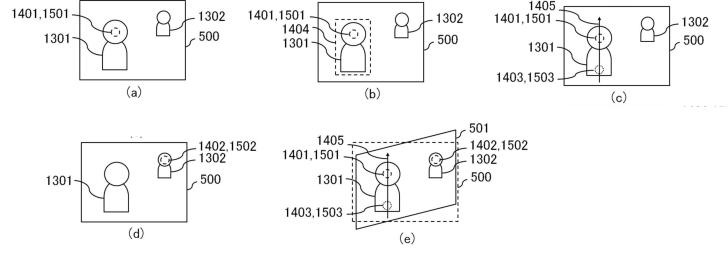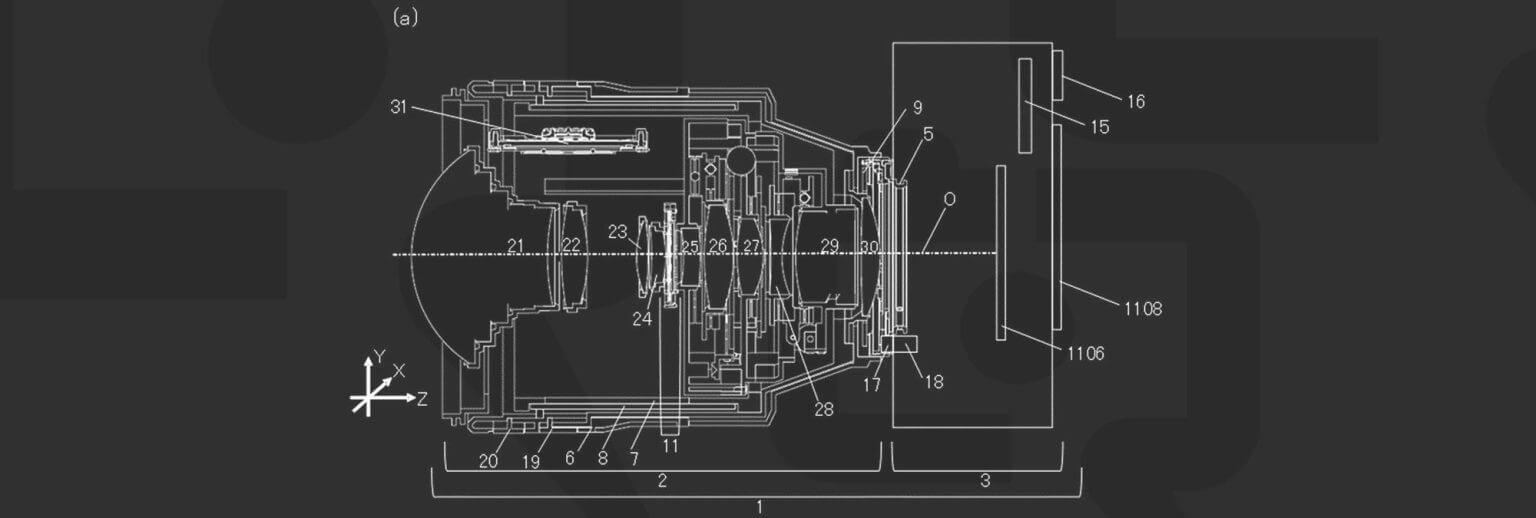This patent application (2024-025274) discusses how to automate the tilt movement given the objects that the user wants in focus, but more importantly when you want to tilt the plane of focus to something other than horizontal or vertical. I believe this is more commonly called swing.
Canon is proposing setting the two focus points and the camera calculating the amount of tilt required to achieve both in focus. Canon seems to indicate that the camera will prompt you to select what type of image you want, for instance, normal or miniature (Diorama effect). The camera after you select the focus points will then calculate everything, and inform if you it's not possible to tilt the lens to that degree, or if it can, move the lens accordingly. We can see in the below diagram, the user chooses the two people in the scene, 1301 and 1302, and swings the tilt-shift lens to get bot of them into the plane of focus.

Canon also proposes in this patent application that by selecting the two points, Canon can recognize a third point of focus automatically and adjust the lens to accommodate all three focus points. In the below diagram, the user selects points 2301 and 2302. Canon then recognizes 2302 in the scene and sets the plan of focus to handle all three points.

I know there was some confusion about this being both a tilt and a shifting lens, Canon states this about the lens;
Moving the sixth lens group 26 and the eighth lens group 28 in a direction perpendicular to the optical axis O, a tilt effect and a shift effect can be obtained.
If I'm reading the patent correctly, please be aware that these patents are being translated from Japanese, so machine readability at times is very confusing, it states that by manipulating element groups 26 and 28 Canon can control the amount of tilt and shift occurring in the lens. The lens itself, not including the fact that it looks like a complex lens, has a ton of internal complexity. So be warned, this may be an eye-watering price to pay. A rough block diagram of the functions of the lens is shown below.

I think it's safe to say we have seen a lot of patent applications on this tilt-shift lens, that there's a lot of smoke, and where this is smoke, most times there is fire. This reminds me again, of the ramp-up to IBIS. We knew it was coming and Canon worked through easily 20+ patent applications detailing their particular implementation of in-body stabilization.
Speaking of which, Canon specifically mentions these lenses as possibly having image stabilization. However, the lens embodiment shown does not particularly contain an IBIS unit. Food for future thought.
As with all patent applications, this is simply a look into Canon's research and may not end up on an actual patent or even a product. But I think this is going to be the “Next big thing”. I have been wrong many times, and Canon certainly has gone down some rabbit holes in terms of researching camera technology, but this seems to be going too far down into research. Not to mention that Canon doesn't have any tilt-shift lenses for the RF mount yet.
Source: Japan Patent Application 2024-025274


Customer: "How about doing that for regular lenses, like you did with the ADEP mode in the past?"
Canon: "No, you need to buy this TS-R lens for that, stopping down is much harder than doing both tilting and shifting!"
Let me ask a question for you more experienced tilt-shifters....
For the miniaturization effect, is it better to have a wider angle TS lens, or a 'normal'? I have a 24mm Tilt-shift, but never really mastered doing the effect. I bought it mostly for pano style frames using shift only, and only tried the tilt thing a few times. What are the tricks to getting a good mini effect?
Brian
But yeah, it would be nice for the camera to offer that capability again.
"Rathaus Basel" – town hall in Basel, Switzerland
EOS 1D X, TS-E 17mm f/4L, 30 s, f/11, ISO 100
Given that we now have the RF10-20/4 and can keystone correct in LS/PS, would this mean that a TS-R lens wouldn't be needed anymore?
You may be overestimating the value of TS beyond the 1:2 magnification Canon put in the last generation of lenses, as I once did. Tilt in particular diminishes as the lens focuses closer, so it isn't practical at high magnifications. I'm hopeful that Canon will deliver 1:2 magnifications at 90mm focal length and beyond.
Anyone interested in a 200mm TS-E lens? I'm curious if folks would have use for a longer length than 135mm...
I hope the aperture is not too closed, the brighter the better for me. Like f2 and below is welcome for portrait models (ex 50mm), even if size/weight/price make it go above the 85 f1.2 or 28-70 f2.
Once they get out an RF 200 f2 (or hopefully something like a 100-200 f2 IS 1.4x or 135-200 1.8 or the like, I'll buy whatever they offer anyway, the EF 200 f2 is that good), this AF TS-E would be my highest-hopped for lens, and a solid reason to stay with Canon.
I think the goal was to tilt the focus plane enough to get the top of a flower completely in focus while photographing it from the side, so close to 90 degrees of focus plane tilt. As you can see from the spreadsheet, that would require stepping back to get a focus distance of at least 65cm.
Here's an example of a test shot using a tripod and the lens at f/4.5. The CA is horrible and even taking in account that the OLPF on the 7D is emulating an uneven layer of petroleum jelly, it's much, much softer than the EF100 non-L I compared it with.